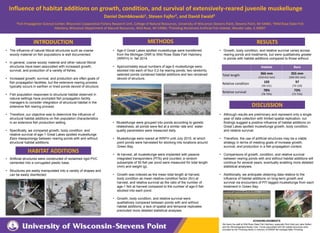Muskie_poster (4)
- 1. Influence of habitat additions on growth, condition, and survival of extensively-reared juvenile muskellunge Daniel Dembkowski1, Steven Fajfer2, and David Ewald3 1Fish Propagation Science Center, Wisconsin Cooperative Fishery Research Unit, College of Natural Resources, University of Wisconsin-Stevens Point, Stevens Point, WI 54481; 2Wild Rose State Fish Hatchery, Wisconsin Department of Natural Resources, Wild Rose, WI 54984; 3Fishiding Reclaimed Artificial Fish Habitat, Wonder Lake, IL 60097 INTRODUCTION âĒ The influence of natural littoral structures such as coarse woody material on fish populations is well documented. âĒ In general, coarse woody material and other natural littoral structures have been associated with increased growth, survival, and production of a variety of fishes. âĒ Increased growth, survival, and production are often goals of fish propagation facilities, but the extensive rearing process typically occurs in earthen or lined ponds devoid of structure. âĒ Fish population responses to structural habitat observed in natural settings have prompted fish propagation facility managers to consider integration of structural habitat in the extensive fish rearing process. âĒ Therefore, our objective was to determine the influence of structural habitat additions on fish population characteristics in an extensive fish production setting. âĒ Specifically, we compared growth, body condition, and relative survival of age-1 Great Lakes spotted muskellunge Esox masquinongy between rearing ponds with and without structural habitat additions. HABITAT ADDITIONS âĒ Artificial structures were constructed of reclaimed rigid PVC cemented into a corrugated plastic base. âĒ Structures are easily manipulated into a variety of shapes and can be easily disinfected. METHODS âĒ Age-0 Great Lakes spotted muskellunge were transferred from the Michigan DNR to Wild Rose State Fish Hatchery (WRFH) in fall 2014. âĒ Approximately equal numbers of age-0 muskellunge were stocked into each of four 0.2-ha rearing ponds; two randomly selected ponds contained habitat additions and two remained devoid of structure. âĒ Muskellunge were grouped into ponds according to genetic relatedness; all ponds were fed at a similar rate and water quality parameters were measured daily. âĒ Muskellunge were reared at WRFH until July 2015, at which point ponds were harvested for stocking into locations around Green Bay. âĒ At harvest, all muskellunge were implanted with passive integrated transponders (PITs) and counted; a random subsample of 50 fish per pond were measured for total length (mm) and weight (g). âĒ Growth was indexed as the mean total length at harvest, body condition as mean relative condition factor (Kn) at harvest, and relative survival as the ratio of the number of age-1 fish at harvest compared to the number of age-0 fish stocked into each pond. âĒ Growth, body condition, and relative survival were qualitatively compared between ponds with and without habitat additions; a lack of spatial and temporal replicates precluded more detailed statistical analyses. RESULTS âĒ Growth, body condition, and relative survival varied across rearing ponds and treatments, but were qualitatively greater in ponds with habitat additions compared to those without. âĒ Although results are preliminary and represent only a single year of data collection with limited spatial replication, our findings suggest a positive influence of habitat additions on Great Lakes spotted muskellunge growth, body condition, and relative survival. âĒ Therefore, the use of artificial structures may be a viable strategy in terms of meeting goals of increase growth, survival, and production in a fish propagation context. âĒ Comparisons of growth, condition, and relative survival between rearing ponds with and without habitat additions will continue for several years, eventually enabling more detailed statistical analyses. âĒ Additionally, we anticipate obtaining data relative to the influence of habitat additions on long-term growth and survival via encounters of PIT-tagged muskellunge from each treatment in Green Bay. DISCUSSION Habitat Bare Total length 366 mm (310-412 mm) 355 mm (304-391 mm) Relative condition 103 (90-141) 97 (76-120) Relative survival 78% (78-79%) 73% (73-75%) ACKNOWLEDGMENTS We thank the staff at Wild Rose State Fish Hatchery, especially Rich Klett and Jake Seifert, and the Winnebagoland Musky Club. Funds associated with the habitat structures were provided by the Primising family in memory of WDNR fish biologist Mike Primising.
